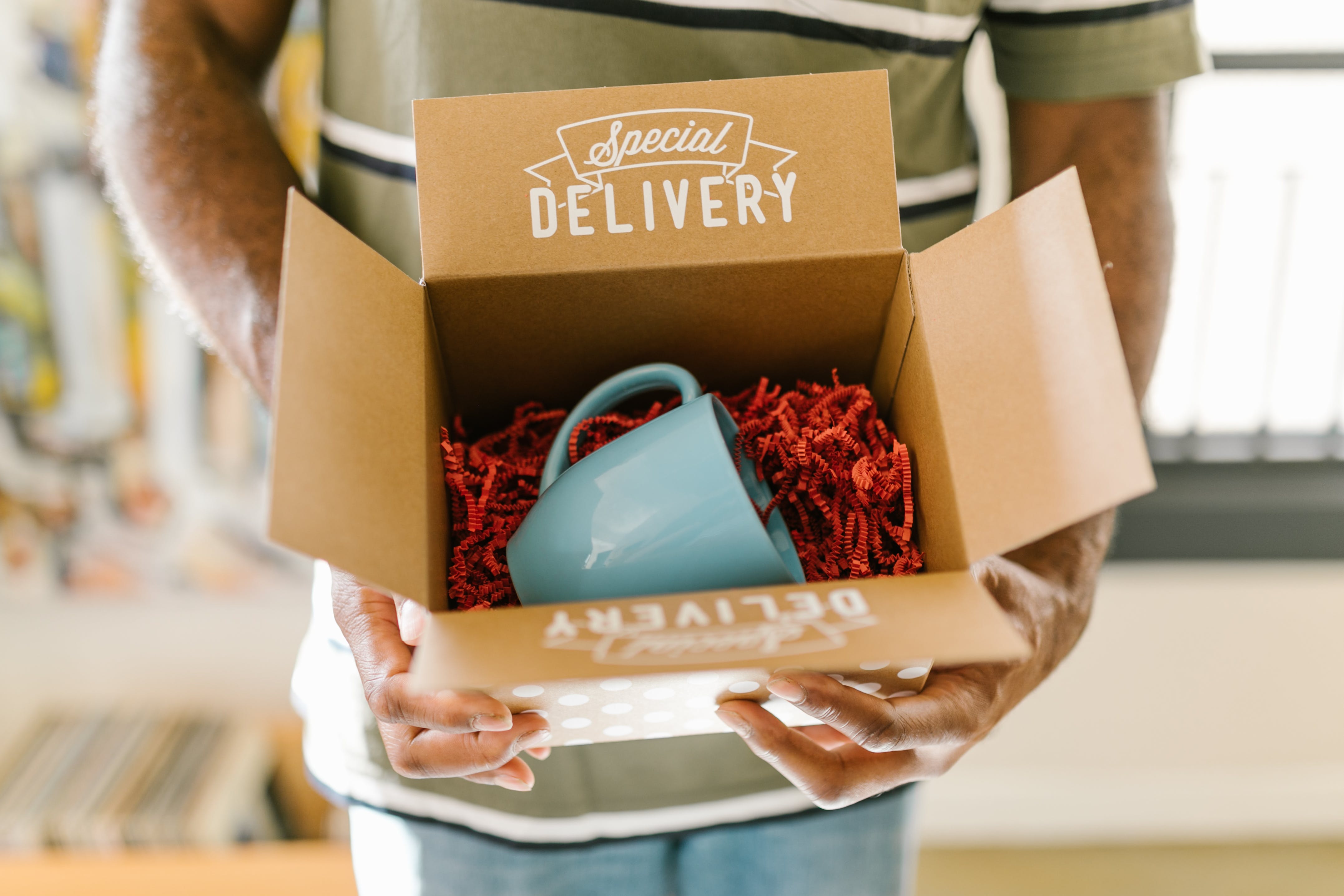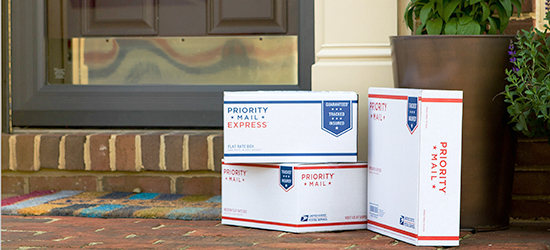Share this
Weighing the Pros and Cons of Custom Shipping Boxes
by Rin Mosher on Dec. 18, 2023

You only get one chance to make a good first impression, and that's especially true with packaging and shipping products. Customized shipping boxes can make all the difference in terms of branding, customer satisfaction, and order fulfillment efficiency. They aren’t without potential drawbacks, though; implementation, assembly, and cost all need to be factored into the decision-making process. Is going the custom route worth it?
Read on as we explore the intricacies of custom shipping boxes and weigh the pros and cons of implementing them in your business' fulfillment process.
What are Custom Shipping Boxes?
There are several aspects of shipping boxes you can customize, such as box dimensions, color, and cardboard type. Businesses often make these special selections based on the product they're selling. For instance, shipping boxes that have custom sizing are often necessary for items that are large or oddly shaped.
Companies may also opt for custom colors or printed designs to match their brand identity. It all comes down to what the business is trying to communicate and how it wants its product represented when it arrives at customers' doorsteps.
Customized Shipping Boxes vs. Regular Corrugated Cardboard Shipping Boxes
There's an important differentiation to be made between customized shipping boxes and the average corrugated cardboard shipping box. While both protect items during transport, the main difference lies in the initial visual presentation to the customer. Customized shipping boxes can come with internal features such as dividers and cutouts, as well as special external designs to accommodate a specific product or brand identity.
On the other hand, a regular corrugated box is usually plain and can only be identified by stock size marks on the outside. Regular slotted box dimensions are standardized (common sizes include 4" x 4" and 8" x 8") while customized shipping boxes can be made based on a specific item's size.
Pros of Custom Shipping Boxes
Deciding to use custom-designed or specially-sized mailer boxes to ship products can be beneficial for many reasons. Here are three of the biggest advantages:
Custom Shipping Boxes are an Excellent Branding Opportunity
Brands can use custom shipping boxes as a means of showcasing their unique brand identity. Exterior prints, stickers, and even packing tape are all simple but effective ways to set your mailer boxes apart from the ones consumers are used to receiving.
Having a unique and attractive packaging design also helps create an unboxing experience that recipients are sure to remember. It’s all about presentation; just like how good first impressions matter in brick-and-mortar retail stores, shipping boxes can contribute to the initial feelings someone has towards an ecommerce business’ brand or product. While premium boxes come at an added cost, many successful brands could attest that including branding on shipping boxes and not just product packaging is worth it for the experience it creates.
Custom Shipping Boxes Help Protect Your Products
Designing custom shipping boxes gives you control over the quality and thickness of cardboard used. Higher-quality materials usually absorb shock and movement and protect against moisture better than standard-issue boxes. You can also opt to further strengthen your shipping box with cardboard inserts that separate items and hold them into place. This will minimize the risk of damage during transit while reducing the practical need for extra dunnage - although you’re free to add it for aesthetic purposes.
The great thing about cardboard is that it’s versatile enough to accommodate virtually any product or design concept. If your products come in fragile packaging, you might use this to your advantage by creating shipping boxes with slots that keep the products in place and facing upwards to show the label. The custom inserts would not only ensure precious cargo remains safe during transit but also present your products in an organized manner when customers receive and open the box.
Custom Shipping Boxes Can Optimize Space and Costs
Standard shipping boxes come in generic sizes that don’t always fit products well. There’s often extra space either heightwise or lengthwise, which increases shipping costs under the dimensional weight pricing system large carriers like UPS, USPS, and FedEx use. Oversized boxes also require more dunnage and storage space, further increasing costs.
Custom shipping boxes that are made to fit your products perfectly eliminate wastage to ensure you’re only paying for what you need – no more and no less.
Cons of Custom Shipping Boxes
While using custom shipping boxes can be great in certain aspects, there are other factors to think about when deciding to use them or not. Be sure to consider these points before making a decision:
Custom Shipping Boxes Can Cost More
While this isn't always the case, custom shipping boxes tend to be more expensive than their regular counterparts. The extra work involved in printing designs and making the boxes to specific sizes adds to production costs and can result in a higher price per box.
Custom Shipping Boxes are Complex
Custom boxes for shipping can be as complicated as you want them to be, but they’re always non-standard. If you design a box with multiple inserts for products or an unusual folding process, it’s likely to complicate assembly and add to labor costs. Depending on your current team and facility’s capabilities, complex boxes also have the potential to slow down the order fulfillment process and impact the number of orders you’re sending out per day. This could then further impact customer satisfaction as buyers wait longer to receive their purchases. One of the easiest ways to achieve the best of both worlds - using custom shipping boxes while keeping order turnaround times low - is by outsourcing to an experienced fulfillment partner like a Third-Party Logistics (3PL) provider.
Custom Shipping Boxes are Time-Consuming
Designing custom shipping boxes can be a time-consuming process. It may take multiple days, weeks, or even months to decide what you want. It's considered best practice to order a sample before going all in on a given design, which only adds to the timeline.
Since customized shipping boxes are made-to-order, they can take more time to supply. Your business will have to wait to receive the boxes from your supplier before using them for orders, which may not be feasible if you have high monthly order volumes and tight turnaround times that your supplier can’t keep up with.
The Final Verdict: Are Custom Shipping Boxes Worth It?
Custom shipping boxes are an option for any ecommerce business, but their complexity might not be right for everyone. Whether going this route is right for you depends on the circumstances at hand. Budget, product type, business goals, and available resources should all be taken into account during the decision-making process. Brands typically choose to use custom shipping boxes when the pros are more significant than the cons, or if they have existing warehousing strategies in place to handle the extra work they can create.
In some cases, a custom box design or size might just make more sense. Subscription packages are a great example of this; the subscription box itself serves as a preview of the products contained within while contributing to the unboxing experience. Custom boxes can also be valuable in cases where a specially-sized box might mean the difference between an item arriving in pristine condition and being damaged during transit.
Want All the Pros of Custom Shipping Boxes But None of the Cons? Work With a 3PL
Only you can decide if the benefits of custom shipping boxes are worth it for your business. But with the right 3PL partner by your side, you can be sure that whatever decision you make will be expertly implemented.
The support of an ecommerce fulfillment partner can be particularly valuable when it comes to assembling custom shipping boxes and fulfilling subscription box orders, as warehouses with the right software systems in place are able to manage multiple sizes and variations of boxes more efficiently. That increased speed has the potential to further benefit your bottom line through decreased labor costs.
Shipfusion's frictionless third-party logistics solutions empower growing ecommerce businesses to scale their operations. Our services are purpose-built to save time, money, and effort, while our dedicated Account Managers act as an extension of your team. When you work with us, you get personalized customer service and reliable technology — all backed by a commitment to helping you succeed in ecommerce. Contact us today to learn more about how we can help you make the most of your fulfillment operations, including using custom shipping boxes.
Share this
You May Also Like
These Related Articles

Perks Of Custom eCommerce Shipping Boxes

What to Consider Before Shipping CBD Products

Choosing Your Order Shipping Carrier: It’s All About Balance!
- April 2025 (18)
- March 2025 (26)
- February 2025 (26)
- January 2025 (37)
- December 2024 (16)
- November 2024 (23)
- October 2024 (22)
- September 2024 (27)
- August 2024 (9)
- July 2024 (8)
- June 2024 (5)
- May 2024 (8)
- April 2024 (8)
- March 2024 (6)
- February 2024 (6)
- January 2024 (5)
- December 2023 (3)
- November 2023 (3)
- October 2023 (5)
- September 2023 (4)
- August 2023 (2)
- July 2023 (1)
- June 2023 (4)
- March 2023 (2)
- October 2022 (1)
- September 2022 (5)
- August 2022 (4)
- July 2022 (7)
- June 2022 (4)
- May 2022 (4)
- April 2022 (6)
- March 2022 (2)
- February 2022 (1)
- January 2022 (3)
- December 2021 (2)
- November 2021 (4)
- October 2021 (2)
- September 2021 (5)
- August 2021 (4)
- July 2021 (4)
- June 2021 (3)
- May 2021 (2)
- April 2021 (3)
- March 2021 (3)
- February 2021 (3)
- January 2021 (2)
- December 2020 (4)
- November 2020 (2)
- October 2020 (4)
- September 2020 (2)
- July 2020 (5)
- June 2020 (4)
- May 2020 (2)
- April 2020 (2)
- March 2020 (4)
- February 2020 (1)
- December 2019 (1)
- May 2018 (1)
- March 2018 (2)
- February 2018 (3)
- January 2018 (3)
- November 2017 (3)
- July 2017 (4)
- March 2017 (3)
- February 2017 (5)
- January 2017 (3)
- December 2016 (4)
- November 2016 (6)
- October 2016 (6)
- October 2015 (1)
- September 2015 (1)
- June 2015 (3)
- May 2015 (3)
- August 2014 (1)
- July 2014 (1)
- March 2014 (1)
- February 2014 (1)